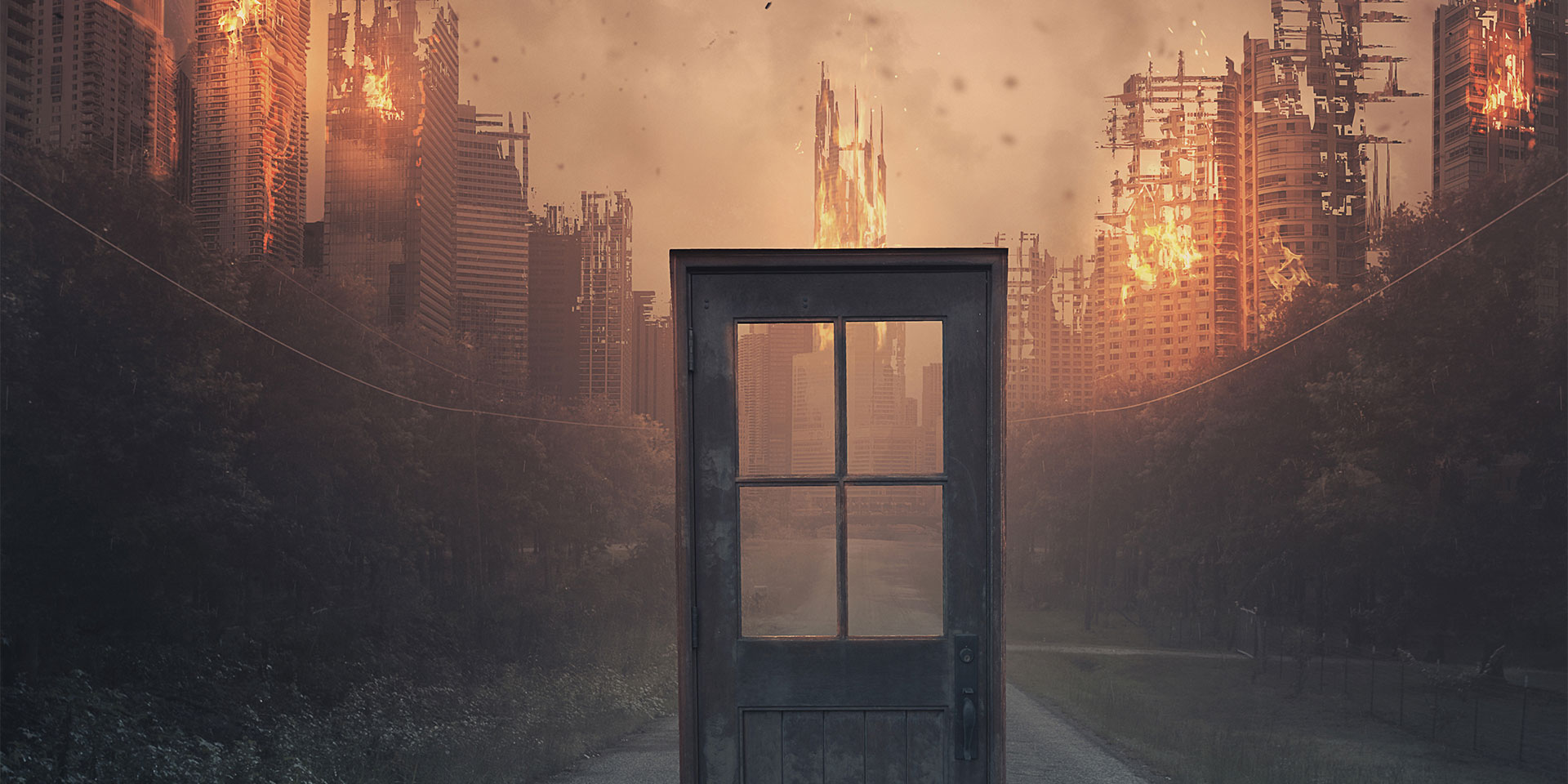The end of the world has been an enduring human preoccupation and, paradoxically, has existed since the dawn of civilisation.
Aristotle wrote that mortals are mortal because they cannot meet their beginning and their end; they can only seek meanings for them.[1] The fear of a complete end is ancient and perennial, and transcends geographical space and time.
Fiction and apocalyptic scenarios
On the emergence of apocalyptic fiction, the historian Lucian Boia has said that the apocalypse has gone from being the private hunting ground of the Church, as it was before the eighteenth century, to being a desacralised subject. Literature has embraced the subject, and the fear has already been partially dispelled.[2]
Fictional texts that focus on the end of the world belong to the established genre of science fiction (sci-fi), more specifically to the subgenre of apocalyptic or eschatological (fictional) literature.
Science fiction imagines a society surprised by the impact of technology and science on human beings. The raw material of this fiction is the major events of history: the atomic bomb, space exploration, world wars, scientific progress, or the technologicalisation of society.
On the other hand, it was science fiction literature that, long before they were realised and confirmed by science, operated fictionally with concepts such as “bio-engineering, quantum architecture, digital graphics, virtual reality, the Internet and social media, space and military technologies, and the automation of production.”[3]
The apocalyptic literary sub-genre focuses exclusively on the theme of the end of the world. Some of these texts, whether or not they explicitly refer to the presence of divinity, take as their source the biblical apocalypse, whose themes and illustrations they exploit fictionally (e.g. Robert Hugh Benson’s Lord of the World [1907] has as its main theme the reign of the Antichrist and the end of the world). Others dispense with the eschatological account in the Bible and construct incredible events that come as a judgement on humanity, involving catastrophes of all kinds, nuclear or technological, biological or astronomical, leading to the extinction of mankind. Many of them depict the existence of the last human being on the planet, such as The Last Man (1826) by Mary Shelley (author of the famous Frankenstein [1818]), in which a humanity at an advanced level of civilisation is destroyed by a plague epidemic between 2073 and 2100, and the last human being wanders the earth awaiting his own extinction.
Apocalyptic fiction tends to be dystopian, not utopian. Dystopia is much more popular than utopia, especially if it is apocalyptic (a utopia in which everything is perfect becomes banal).
The dystopian world is a society ruled by totalitarian political systems, a nation-state under the rule of an elite that has no interest in the welfare of the people, with state propaganda systems and imposed education programmes that convey the message that current policies are the best possible option. These dystopias—see George Orwell’s novel 1984 (written in 1948), or Aldous Huxley’s Brave New World (1932), or Boualem Sansal’s recent 2084: The End of the World (2015) (an obvious reference to Orwell’s novel)—warn of the misguided development of social, political or religious systems.
But how can we explain the existence of fictions aimed at modern sentiments?
Whether the modern mind likes it or not, the decline of mythical thinking is reversible. The modern world abounds in myths, and the entertainment industry is only one source. Universal archetypes and role patterns are well preserved in modern fiction. The genres of fantasy, horror, and science fiction are relevant in this respect, as they create models for relating to life that are appropriate to the times in which we live. The need for myths or heroes, however, remains constant: M.P. Shiel’s hero from The Purple Cloud, wandering as a ruler in a desolate world, is another Nero triumphing at the sight of the smoking ruins of Rome.[4]
Fictions about superheroes, artificial intelligence, monsters, beginnings (cosmogonies) or the end of the world (apocalypses) are already regularly presented to us, and symbolise variations on our understanding of reality; new myths that try to explain the inexplicable. Contemplation of the apocalypse makes everyday problems seem trivial.
By its very nature, the idea of the end of the world (it has been said that the apocalypse is “an extreme cultural trauma”[5]) is one of humanity’s most fascinating curiosities, because it satisfies our desire for mystery, curiosity, wonder, and horror.
Are they new forms of eschatological myths? On the other hand, the original, traditional eschatological myths, according to Mircea Eliade, had a different purpose: they led to important collective movements in the Middle Ages (the Crusades, millenarianism, Columbus’ expedition, etc.).[6]
Such a myth has shaped American culture, which has always seen itself as apocalyptic.[7] The American world has always seemed open to all hopes and utopias. The Pilgrims and Puritans of New England were convinced that their existence in the New World was part of a divine plan that would inevitably lead to the establishment of the New Jerusalem on the American continent; moreover, the sermons of the Puritans were full of references to the end of the world, and all this led Americans, from the very beginning of their nation, to believe that the history of the United States would not be accidental, but part of divine history.
End-of-world themes are often explored in contemporary literary fiction because they correspond to real dilemmas and represent a type of literature that is hard-hitting and provocative in its questions: decay and restoration, progress and catastrophe, or political power.
There is a close link between the apocalypse and the idea of state power, of empire, because the concepts of crisis, decadence, and empire help society to see nations, wars, and empires in relation to the end of the world. Unstable historical terrains tend to favour fictional apocalyptic solutions.
From the perspective of literary history, the end of the world has corresponded well with literary Romanticism, in keeping with its artistic motifs: mystery, fantasy, the macabre, the oneiric, the tenebrous, the preoccupation with time and space, and exceptional characters and situations. “By 1850,” writes Lucian Boia, “all the formulas were in place: immediate end and long-term end, providential end and natural end, definitive end and renewal. The literature of the end of the world had begun its beautiful career.”[8]
How does the world end in literature?
Before it perished in its materiality, the world was annihilated with the help of the imagination.[9] We could say that the apocalyptic imagination knows no bounds. Thus the world ends in literature through nuclear wars, drastic climate changes, pandemics, famines, volcanic eruptions, alien or animal invasions, the supremacy of robots, biological revolutions, meteorite collisions, and so on.
H.G. Wells, a leading British writer in the science fiction genre, wrote many fictions that compete in depicting the most catastrophic end of the world. The Time Machine (1895) presents a dystopia; The War of the Worlds (1898), an alien invasion; The Island of Dr Moreau (1896), genetic manipulation; The Shape of Things to Come (1933), a world war. With the 1950s, American popular culture experienced an explosive boom—the science fiction genre gained a growing and younger audience, while the theme of the end of the world became a common one, thanks to the popularisation of the atomic bomb and the growing interest in space exploration.[10] Thus, many mid-century writers overplayed the theme of nuclear destruction: Arthur C. Clarke in Childhood’s End (1953), Walter Miller in A Canticle for Leibowitz (1959), Kurt Vonnegut in Cat’s Cradle (1963), Robert C. O’Brien in Z for Zachariah (1974). In Aldous Huxley’s Ape and Essence (1948), nuclear war leads to a strange world of mutants with rules that are difficult to imagine.
In the twentieth century, the impact of human activity on the ecological balance and climate change is increasingly questioned. Apocalyptic fiction now works out a new way to end humanity.
Examples include George R. Stewart’s Earth Abides (1949), John Christopher’s The Death of Grass (1956), and J.G. Ballard’s The Wind from Nowhere (1961) (before suggesting in his latest novel, Kingdom Come (2006), that it is consumerism rather than environmental degradation that will bring about the end of civilisation). In 1954, Richard Matheson’s I Am Legend imagined a bacterium that turned almost all humans into vampires, while Michael Crichton’s The Andromeda Strain (1969) described the trajectory of a satellite returning to Earth with a deadly pathogen.
Yet the theme is an old one: Edgar Quinet, who had originally conceived a work on the classical religious model entitled Ahasvérus, wrote La Création (Creation) in the 1870s, in which he wondered whether humanity’s place might be taken by a superior race. Guy de Maupassant (in The Horla [1887]) was also concerned with the same questions. Like them, many writings of the 19th century bear the Darwinian stamp. There was no shortage of doomsday pandemics, as international travel made rapid infection with various viruses possible, echoing the biblical theme of plagues.
In the 1900s, social angst shifted to objects and dangers in space.[11] The collision of the earth with meteorites became another way of imagining the end of the world. In The Conversation of Eiros and Charmion (1839), Edgar Allan Poe speaks of a comet that will scorch the planet. In Ray Bradbury’s The Martian Chronicles (1951), the Earth blows up and a few survivors continue their existence on Mars (in the middle of the last century, the idea of living on Mars was still being entertained).
Is apocalyptic fiction simply a form of escapism, an escape from the mundane? Or does it have certain meanings?
Science fiction, especially its apocalyptic subgenre, is almost always allegorical and political.[12] Apocalyptic fiction takes a fatalistic view and is highly critical of society, conveying the message that humanity’s demise is the result of its own decay and destruction. The worst human impulses and behaviours are revealed in the run-up to the final events.
Writers and readers agree: the world and humanity are heading for final chaos; Armageddon or dystopian worlds express it best. That’s why the warning signal is serious—re-evaluate the social and political life of today’s world and fight for a better life before it’s too late. Catastrophes point to ancient existential anxieties.
War with the Newts (1936) is a famous satirical masterpiece in which Karel Čapek depicts the bitter struggle with an out-of-control nature. Newts, which individuals use for profit, multiply and come to dominate the earth, just like humans. But the story is allegorical and socially engaged. The real enemy of humanity is not the creatures of the story, but the fascist invasion that threatens the civilised world. Whether they are invaders from Mars, mutant monsters, savages, technocrats or ultimately Nazis, they represent the “other,” the dehumanised self, as in Eugène Ionesco’s play Rhinoceros, where animated nature reveals the alienation that profoundly affects the human condition and world history.[13]
Other interpretations show that the various eschatological variants, especially those caused by natural disasters, can be a metaphor for internal human conflicts. They are said to symbolise the “destructive impulses within the self: the death-wish in all its homicidal and suicidal forms.”[14] In a sense, the writers are calling our attention to the enemy within, “to the forces that contrive private doomsdays in the muck of the id”[15] (see M.P. Shiel, in The Purple Cloud [1901]).
In her article, “The Appeal of the Apocalypse” Karen Renner writes that people may be looking for something more than the temporary comfort of adrenaline-induced amnesia.[16] Beyond a pessimistic contemplation on the corruption of the world, fiction invites experiences that reveal undiscovered human potential and, surely, another world: a necessarily better one.
Laura Maftei, PhD, is a professor in the Faculty of Theology and Social Sciences at Adventus University.


















